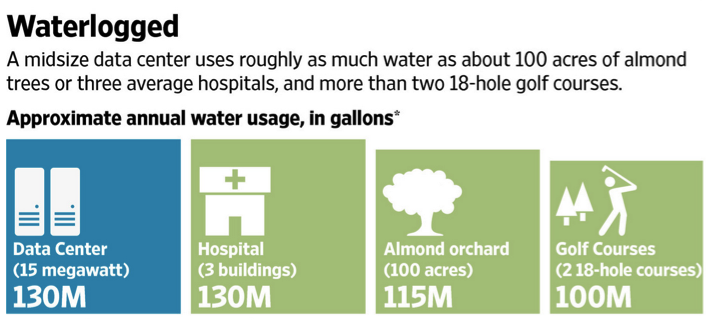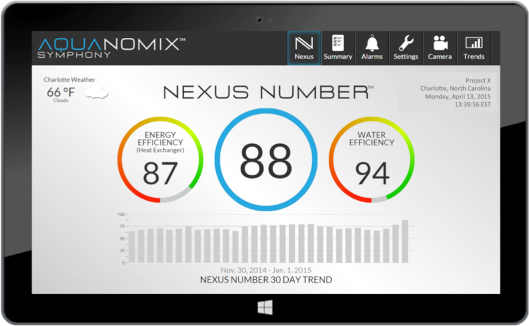
|
August 2015 |
[an error occurred while processing this directive] |
|
Don't Forget About Water
Data centers consume roughly as
much water in a year as 158,000 Olympic sized swimming pools.
|
Kristen Bauer
Brand Strategist & Robert O'Donnell, Managing Partner |
| Articles |
| Interviews |
| Releases |
| New Products |
| Reviews |
| [an error occurred while processing this directive] |
| Editorial |
| Events |
| Sponsors |
| Site Search |
| Newsletters |
| [an error occurred while processing this directive] |
| Archives |
| Past Issues |
| Home |
| Editors |
| eDucation |
| [an error occurred while processing this directive] |
| Training |
| Links |
| Software |
| Subscribe |
| [an error occurred while processing this directive] |
The
Wall Street Journal reported in June 2015 that, “California has more
than 800 data centers, the most of any state. Based on that and
estimates for water use, the state’s data centers consume roughly as
much water in a year as 158,000 Olympic sized swimming pools.”
“A midsize 15-megawatt center uses between 80 million and 130 million
gallons of water a year for cooling, according to industry estimates.
At the high end of that range, each new facility is akin to planting
100 acres of almond trees, adding three hospitals or opening more than
two 18-hole golf courses.”

California Governor Jerry Brown has ordered cities across the state to cut annual water use by 25% - immediately.
______________
1http://www.wsj.com/articles/SB10007111583511843695404581067903126039290

The report stated what we in the
industrial water and controls industry already know, that, “Data
centers aren’t the state’s biggest water users. But they generally
require municipally provided clean, treated water like restaurants and
hotels. Agriculture, which accounts for roughly 80% of water use in the
state, can use untreated water from streams and lakes. Electric
utilities, the state’s second largest water consumer, also can
sometimes use salt water.”
Addressing how water treatment directly impacts heat exchange, energy
use, and water use will ultimately lead to a better water management
program, lower operating costs, and a significant improvement in
sustainable facilities management. Capital assets (hvac equipment) will
be preserved, postponing a capital event, leading to a stronger P&L
for the facility owner. While these new programs may be more demanding,
this type of service has significantly better profit margins, as
compared against open bid arrangements with no performance metrics to
define program success.
Historically, controls technology platforms allowed for treating these
operating systems by looking primarily at water quality data, and
maintained the water conditions using that singular data set. For
example, if the system ORP was low, then a subsequent increase in the
oxidant feed was delivered. However if the pollen count was high due to
seasonal conditions, we waited until we had a visual confirmation (by
visual inspection or by test) of resultant biological development and
then subsequently increased the biocide dosage.
We treated the water to keep a heat exchanger clean, but the water
treatment controller never received verification that the heat
exchanger was clean. There was no feedback from the building automation
system to the treatment system.
When it comes to commercial and industrial HVAC systems, cooling towers
tend to receive less attention than other HVAC system components.
According to Chris Walton of Baltimore Aircoil Co., “The cooling tower
is often the forgotten component of the system when it comes to
maintenance.”2
Yet, cooling tower maintenance is critical to ensuring overall system
efficiency, abating critical asset failure, and preventing downtime.3
Todd Beard, regional operations director, Lee Co., Franklin, Tennessee,
noted, “When a process or piece of cooling equipment depends on a
heat-rejection device such as a cooling tower to function properly,
there are not many alternatives that will work in the event the tower
fails. In other words, there is typically not a cooling tower sitting
in a warehouse somewhere ready to be installed at a moment’s notice.
It’s not a matter of if a poorly or non-maintained tower is going to
fail — it’s when.”
And, Beard added, “That is when Murphy’s Law comes into play, and the
failure occurs at the most inopportune moment; it happens every time.”
Water quality in industrial and commercial HVAC systems requires smart
instrumentation for analysis, allowing you to proactively address
problems arising from changing make up water chemistries. It also
requires smarter control methods to predict and respond to upcoming
conditions that could cause corrosion, scaling, fouling, or microbial
upsets. This newer control technology must be connected to the systems
being treated so that the controller is not blindly treating water for
a heat exchange system it cannot see. Instead the control software
architecture that monitors the water quality characteristics should
also look at the hvac system heat exchange performance data, and
preferably, the atmospheric conditions as well.
Marrying the water quality data with the hvac system performance data
allows the advanced controls system the opportunity to aggregate and
analyze data by running algorithms to determine underperforming system
components.
______________
2http://www.achrnews.com/articles/129575-dont-ignore-that-cooling-tower
3http://www.achrnews.com/articles/105135-cooling-tower-safety-and-maintenance
SYSTEM BENCHMARKING
You’ve heard the same adage over and over again. You cannot manage what
you do not measure. It’s all about the data, but without a benchmark or
a way to structure data, it renders this potentially valuable resource
as little to no value to a facility manager or enterprise level
executive. It must be organized in a cohesive way to explain the data
relationships – in this case, the relationship between heat exchange
(energy efficiency) and water quality.

We don’t know what we don’t know.
Facilities managers, enterprise managers, building owners, the
powers-that-be expect, and usually require, a veritable return on their
investment in data – information that empowers them to make the right
decisions. Data and knowledge provide power – understanding how and why
heat exchangers are functioning at any given moment is powerful.
Combining that previously disparate knowledge of the cooling system
operations is priceless.
Data is power.
That is the magic of an effective benchmarking tool – giving the owner,
the manager, whoever – the visibility, full transparency of what they
are spending on water and energy – and who is responsible for any
inefficiencies and OpEx expenditure.
It’s also effective from an enterprise level – benchmarking each system
against one another to garner the relational data between all
facilities/buildings in an enterprise portfolio.
The value in a technology that marries energy and water quality data is
powerful. It reveals transparency of operating costs and water quality
management at such a granular level. The data supports swift and
intelligent decision-making processes, which can save money and improve
outcomes in performance.
Symphony™ helps data centers, other critical facilities, any commercial
or industrial building improve reliability and efficiency. By
continuously monitoring and analyzing the water quality and energy use,
you minimize risk, both critical and operational. As a result, you can
get the reliability that management demands.
[an error occurred while processing this directive]
Here’s how it works:
The numbers don’t lie.
84% of data center managers would rather walk barefoot over hot coals
than endure data center downtime, but 91% experienced an unplanned
outage in the past 24 months.
32% of all unplanned outages in commercial and industrial buildings
result from water-related issues at an estimated $500,000+ per outage.4

Data centers average one complete outage per year – each complete data center outage costs an average of $901,560.5
______________
4 Emerson Network Power: http://www.emersonnetworkpower.com/en-US/Solutions/infographics/Pages/Causes_of_Downtime.aspxand
http://www.emersonnetworkpower.com/documentation/en-us/brands/liebert/infographics/documents/ponemon-infographic-cost%20of%20downtime-r11-13-
final.pdf
5http://www.emersonnetworkpower.com/en-US/Solutions/infographics/Pages/State-of-the-Data-
Center-2013-Infographic.aspx

It’s tough to manage what you can’t, or
don’t, measure. If the main goal of a maintenance or facility
professional is to maintain an efficient and operational HVAC system,
while maintaining today’s critical sustainability component, smart
water and energy efficiency technologies must be implemented into
commercial and industrial buildings.
About the Author
Kristen A. Bauer, Brand Strategist
Kristen Bauer is the Brand Strategist
at Aquanomix, LLC, based in Davidson, North Carolina, and has more than
ten years of experience in the marketing and advertising industry.
Kristen specializes in marketing, communications and advertising in the
diverse industries of professional sports and engineering.
Prior to launching the revolutionary new Symphony water management and
optimization software for Aquanomix, she worked seven years for NASCAR,
Inc., as well as working in the advertising agency world managing and
strategically promoting Fortune 100 clients.
Kristen is a member of the American Marketing Association.
[an error occurred while processing this directive]
[Click Banner To Learn More]
[Home Page] [The Automator] [About] [Subscribe ] [Contact Us]